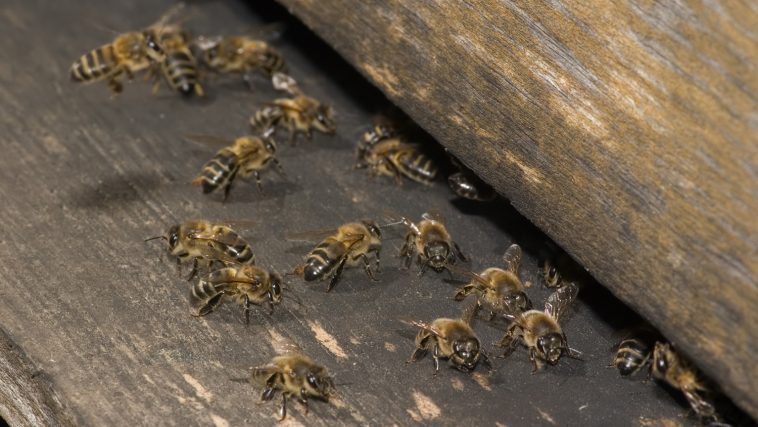[Originally gathered as part of the Thank God for Insects page. Editor’s note: It’s always a delight to see the ingenuity God lavished on his many-legged micro creations. Today we share just a few things we’ve learned in the past few years about a single insect, the bee.]
Honey Bee RNA ‘Vaccines’
[While it’s a matter of controversy in today’s politicized climate, God’s been using this technique since Adam ate the fruit. Now, it’s only a question of whether we’re smart enough to copy him!]
May 2, 2019 Researchers have discovered that honey bees are able to share immunity with other bees and to their offspring in a hive by transmitting RNA ‘vaccines’ through royal jelly and worker jelly.
These transmissible RNA molecules are produced by the honey bee’s genes and by disease agents such as viruses. Unlike other RNA in the body, these RNA molecules do not code for protein. Instead, they play a direct role in immunity, gene regulation and other biological mechanisms.
Dr Maori added: “Honey bees have evolved a type of ‘glue’ that binds RNA into granules, making it more stable and so able to be shared with other bees. If we can harness this technology, we might be able to use it to develop new ‘vaccines’ that could be used in agricultural settings, in particular to help immunize bees against the devastating losses being suffered by their colonies. “It is possible that this honey bee protein may even have applications, too, for new vaccines and medicines for humans.”
Bee Air Conditioning
[Can you spot where this report moves from the factual to the imaginary and then back again? If you don’t ask yourself whether the scientists have been observing this develop for millennia, you would think they had been eyewitnesses of how they “evolved.”]
February 8, 2019 Honey bees live in large, congested nest cavities, often in tree hollows with narrow openings. When it gets hot inside the nest, a group of bees crawl to the entrance and use their wings as fans to draw hot air out and allow cooler air to move in. The question is, how do bees self-organize into these living ventilating units? Researchers…have developed a framework that explains how bees use environmental signals to collectively cluster and continuously ventilate the hive.
Over millennia, social insects such as bees have evolved to harness and exploit flows and forces and collectively solve physiological problems such as mechanical stabilization, thermoregulation and ventilation on scales much larger than the individual…
“In everything from large HVAC systems to the fans that cool our computers, bioinspired, self-organizing systems may be able to adapt and respond to specific demands better than current systems,” said Peters.
~Science Daily.com
Honey Bee Mathematics
[Do you know how long it took humans to really process the concept of zero in most societies? To think God wired a bug to understand it!]
December 2018 Bees can solve seemingly clever counting tasks with very small numbers of nerve cells in their brains.
In order to understand how bees count, the researchers simulated a very simple miniature ‘brain’ on a computer with just four nerve cells — far fewer than a real bee has. The ‘brain’ could easily count small quantities of items when inspecting one item closely and then inspecting the next item closely and so on, which is the same way bees count. This differs from humans who glance at all the items and count them together.
The researchers propose that this clever behaviour makes the complex task of counting much easier, allowing bees to display impressive cognitive abilities with minimal brainpower.
Previous studies have shown bees can count up to four or five items, can choose the smaller or the larger number from a group and even choose ‘zero’ against other numbers when trained to choose ‘less’.
This finding demonstrates that the intelligence of bees, and potentially other animals, can be mediated by very small nerve cells numbers, as long as these are wired together in the right way. The study could also have implications for artificial intelligence because efficient autonomous robots will need to rely on robust, computationally inexpensive algorithms, and could benefit from employing insect-inspired scanning behaviours.
~Science Daily.com
Antibiotic Venom
[We always need help fighting off God’s tiniest living creatures. It will be interesting to see whether this works out someday.]
December 2018 The venom of insects such as wasps and bees is full of compounds that can kill bacteria… After performing a systematic study of the antimicrobial properties of a toxin normally found in a South American wasp, researchers at MIT have now created variants of the peptide that are potent against bacteria but nontoxic to human cells.
The researchers have begun creating additional variants that they hope will be able to clear infections at lower doses.
Designed for Inflight Balance
[I love to think of scientists who are excited to find out new things about a single, well-studied aspect of creation. How fun to picture honeybees being carefully observed by serious people with the intelligence to grasp just how special these insects are. If only they could also appreciate how amazing their Creator is as well.]
If you’ve ever lost your balance standing on a bus that takes a sharp turn at speed or felt your car skid when you drive around a corner too fast, you’ve experienced the effects of centrifugal force.
The study by PhD student Mr Mahadeeswara Mandiyam and Professor Srinivasan at the Queensland Brain Institute, UQ, used a high-speed-multi-camera system to capture video footage of bees…
The high speed videos were analysed mathematically to study the flight behaviour of bees in the cloud. Professor Srinivasan and Mr Mandiyam hoped to better understand the complex manoeuvre of maintaining a desired flight trajectory while turning without disruption from centrifugal force. The bees’ speed, acceleration, and sharpness of turn were all computed using vector calculus to investigate how bees maintain control while turning.
They hope to use a greater understanding of bee flight behaviour to incorporate in aerial robots and ground vehicles with advanced flight control and navigational abilities. “Our main goal is to see how bees avoid collisions.
Bee flight patterns have long been of interest to Professor Srinivasan and his lab. They hope to use a greater understanding of bee flight behaviour to incorporate in aerial robots and ground vehicles with advanced flight control and navigational abilities.
“We can apply our knowledge of how bees perform coordinated turns to these situations to avoid sideslips in aerial and ground vehicles.”







